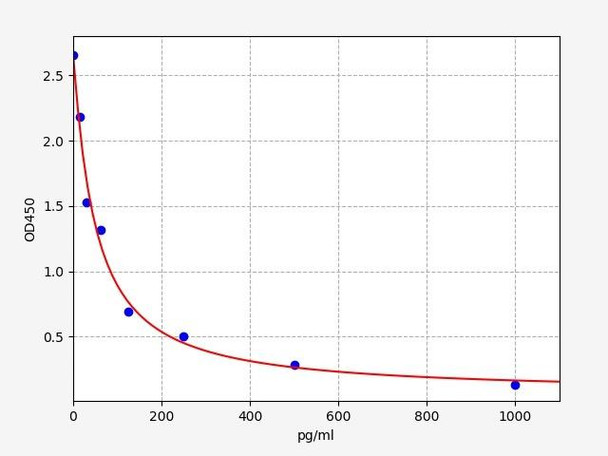Mouse C-type natriuretic / NPPC ELISA Kit (MOFI00285)
- SKU:
- MOFI00285
- Product Type:
- ELISA Kit
- Size:
- 96 Assays
- Uniprot:
- Q61839
- Sensitivity:
- 9.375pg/ml
- Range:
- 15.625-1000pg/ml
- ELISA Type:
- Competitive
- Synonyms:
- Nppc, CNP, CNP2, C-type natriuretic peptide, natriuretic peptide C, natriuretic peptide precursor C
- Reactivity:
- Mouse
- Research Area:
- Cell Biology
Description
Mouse C-type natriuretic/NPPC ELISA Kit
The Mouse C-Type Natriuretic NPPC ELISA Kit is specifically designed for the accurate and reliable detection of NPPC levels in mouse serum, plasma, and cell culture supernatants. This kit offers high sensitivity and specificity, providing consistent and reproducible results for a variety of research applications.NPPC, also known as C-type natriuretic peptide, is a key regulator of cardiovascular and renal function, playing a crucial role in the regulation of blood pressure and fluid balance.
Elevated levels of NPPC have been associated with various cardiovascular diseases, making it a valuable biomarker for studying these conditions and developing potential therapeutic interventions. With its user-friendly design and superior performance, the Mouse C-Type Natriuretic NPPC ELISA Kit is an essential tool for researchers looking to explore the role of NPPC in cardiovascular health and disease.
| Product Name: | Mouse C-type natriuretic / NPPC ELISA Kit |
| Product Code: | MOFI00285 |
| Size: | 96 Assays |
| Alias: | Nppc, CNP, CNP2, C-type natriuretic peptide, natriuretic peptide C, natriuretic peptide precursor C |
| Detection Method: | Competitive ELISA |
| Application: | This immunoassay kit allows for the in vitro quantitative determination of Mouse Nppc concentrations in serum plasma and other biological fluids. |
| Sensitivity: | 9.375pg/ml |
| Range: | 15.625-1000pg/ml |
| Storage: | 4°C for 6 months |
| Note: | For Research Use Only |
| Recovery: | Matrices listed below were spiked with certain level of Mouse Nppc and the recovery rates were calculated by comparing the measured value to the expected amount of Mouse Nppc in samples. | ||||||||||||||||
| |||||||||||||||||
| Linearity: | The linearity of the kit was assayed by testing samples spiked with appropriate concentration of Mouse Nppc and their serial dilutions. The results were demonstrated by the percentage of calculated concentration to the expected. | ||||||||||||||||
| |||||||||||||||||
| Intra Assay: | CV <8% | ||||||||||||||||
| Inter Assay: | CV <10% |
| Component | Quantity | Storage |
| ELISA Microplate(Dismountable) | 8-12 strips | 4°C for 6 months |
| Lyophilized Standard | 2 | 4°C/-20°C |
| Sample/Standard Dilution Buffer | 20ml | 4°C |
| Biotin-labeled Antibody(Concentrated) | 60ul | 4°C (Protect from light) |
| Antibody Dilution Buffer | 10ml | 4°C |
| HRP-Streptavidin Conjugate(SABC) | 120ul | 4°C (Protect from light) |
| SABC Dilution Buffer | 10ml | 4°C |
| TMB Substrate | 10ml | 4°C (Protect from light) |
| Stop Solution | 10ml | 4°C |
| Wash Buffer(25X) | 30ml | 4°C |
| Plate Sealer | 5 | - |
Other materials and equipment required:
- Microplate reader with 450 nm wavelength filter
- Multichannel Pipette, Pipette, microcentrifuge tubes and disposable pipette tips
- Incubator
- Deionized or distilled water
- Absorbent paper
- Buffer resevoir
| Uniprot | Q61839 |
| UniProt Protein Function: | NPPC: Hormone which plays a role in endochondral ossification through regulation of cartilaginous growth plate chondrocytes proliferation and differentiation. May also be vasoactive and natriuretic. Specifically binds and stimulates the cGMP production of the NPR2 receptor. Binds the clearance receptor NPR3. Belongs to the natriuretic peptide family. |
| UniProt Protein Details: | Protein type:Hormone; Secreted; Secreted, signal peptide Chromosomal Location of Human Ortholog: 1 C5|1 43.98 cM Cellular Component: extracellular region; extracellular space; protein complex; secretory granule Molecular Function:hormone activity; neuropeptide hormone activity; peptide hormone receptor binding; protein homodimerization activity; receptor binding Biological Process: animal organ development; cGMP biosynthetic process; negative regulation of cell proliferation; negative regulation of DNA metabolic process; negative regulation of meiotic cell cycle; ossification; positive regulation of cGMP biosynthetic process; positive regulation of osteoblast differentiation; post-embryonic development; protein folding; receptor guanylyl cyclase signaling pathway; regulation of blood vessel size; regulation of cAMP metabolic process; regulation of cGMP metabolic process; regulation of multicellular organism growth; reproductive process |
| NCBI Summary: | This gene encodes a member of the natriuretic peptide family. Natriuretic peptides are involved in the control of blood pressure, extracellular fluid volume and electrolyte homeostasis. The encoded protein also plays a role in sensory neuron bifurcation, and is a critical regulator of endochondral bone growth. The encoded protein is a ligand for the natriuretic peptide receptor B, and is synthesized as a preprohormone which is cleaved to produce a mature peptide. Mutations in this gene are associated with dwarfism resulting from impaired endochondral ossification. [provided by RefSeq, Apr 2011] |
| UniProt Code: | Q61839 |
| NCBI GenInfo Identifier: | 6754880 |
| NCBI Gene ID: | 18159 |
| NCBI Accession: | NP_035063.1 |
| UniProt Related Accession: | Q61839 |
| Molecular Weight: | 13,320 Da |
| NCBI Full Name: | C-type natriuretic peptide preproprotein |
| NCBI Synonym Full Names: | natriuretic peptide type C |
| NCBI Official Symbol: | Nppc |
| NCBI Official Synonym Symbols: | CNP; lbab |
| NCBI Protein Information: | C-type natriuretic peptide |
| UniProt Protein Name: | C-type natriuretic peptide |
| Protein Family: | C-type natriuretic peptide |
| UniProt Gene Name: | Nppc |
*Note: Protocols are specific to each batch/lot. For the correct instructions please follow the protocol included in your kit.
| Step | Procedure |
| 1. | Set standard, test sample and control (zero) wells on the pre-coated plate respectively, and then, record their positions. It is recommended to measure each standard and sample in duplicate. Wash plate 2 times before adding standard, sample and control (zero) wells! |
| 2. | Add Sample and Biotin-detection antibody: Add 50µL of Standard, Blank or Sample per well. The blank well is added with Sample Dilution Buffer. Immediately add 50 µL of biotin-labelled antibody working solution to each well. Cover with the plate sealer provided. Gently tap the plate to ensure thorough mixing. Incubate for 45 minutes at 37°C. (Solutions are added to the bottom of micro-ELISA platewell, avoid touching plate walls and foaming). |
| 3. | Wash: Aspirate each well and wash, repeating the process three times. Wash by filling each well with Wash Buffer (approximately 350µL) using a squirt bottle, multi-channel pipette, manifold dispenser orautomated washer. Complete removal of liquid at each step is essential to good performance. After the last wash, remove any remaining Wash Buffer by aspirating or decanting. Invert the plate and pat it against thick clean absorbent paper. |
| 4. | HRP-Streptavidin Conjugate(SABC): Add 100µL of SABC working solution to each well. Cover with a new Plate sealer. Incubate for 30 minutes at 37°C. |
| 5. | Wash: Repeat the aspiration/wash process for five times. |
| 6. | TMB Substrate: Add 90µL of TMB Substrate to each well. Cover with a new Plate sealer. Incubate for about 10-20 minutes at 37°C. Protect from light. The reaction time can be shortened or extended according to the actual color change, but not more than 30minutes. When apparent gradient appeared in standard wells, you can terminate the reaction. |
| 7. | Stop: Add 50µL of Stop Solution to each well. Color turn to yellow immediately. The adding order of stop solution should be as the same as the substrate solution. |
| 8. | OD Measurement: Determine the optical density (OD Value) of each well at once, using a microplate reader set to 450 nm. You should open the microplate reader ahead, preheat the instrument, and set the testing parameters. |
When carrying out an ELISA assay it is important to prepare your samples in order to achieve the best possible results. Below we have a list of procedures for the preparation of samples for different sample types.
| Sample Type | Protocol |
| Serum: | If using serum separator tubes, allow samples to clot for 30 minutes at room temperature. Centrifuge for 10 minutes at 1,000x g. Collect the serum fraction and assay promptly or aliquot and store the samples at -80°C. Avoid multiple freeze-thaw cycles. If serum separator tubes are not being used, allow samples to clot overnight at 2-8°C. Centrifuge for 10 minutes at 1,000x g. Remove serum and assay promptly or aliquot and store the samples at -80°C. Avoid multiple freeze-thaw cycles. |
| Plasma: | Collect plasma using EDTA or heparin as an anticoagulant. Centrifuge samples at 4°C for 15 mins at 1000 - g within 30 mins of collection. Collect the plasma fraction and assay promptly or aliquot and store the samples at -80°C. Avoid multiple freeze-thaw cycles. Note: Over haemolysed samples are not suitable for use with this kit. |
| Urine & Cerebrospinal Fluid: | Collect the urine (mid-stream) in a sterile container, centrifuge for 20 mins at 2000-3000 rpm. Remove supernatant and assay immediately. If any precipitation is detected, repeat the centrifugation step. A similar protocol can be used for cerebrospinal fluid. |
| Cell culture supernatant: | Collect the cell culture media by pipette, followed by centrifugation at 4°C for 20 mins at 1500 rpm. Collect the clear supernatant and assay immediately. |
| Cell lysates: | Solubilize cells in lysis buffer and allow to sit on ice for 30 minutes. Centrifuge tubes at 14,000 x g for 5 minutes to remove insoluble material. Aliquot the supernatant into a new tube and discard the remaining whole cell extract. Quantify total protein concentration using a total protein assay. Assay immediately or aliquot and store at ≤ -20°C. |
| Tissue homogenates: | The preparation of tissue homogenates will vary depending upon tissue type. Rinse tissue with 1X PBS to remove excess blood & homogenize in 20ml of 1X PBS (including protease inhibitors) and store overnight at ≤ -20°C. Two freeze-thaw cycles are required to break the cell membranes. To further disrupt the cell membranes you can sonicate the samples. Centrifuge homogenates for 5 mins at 5000xg. Remove the supernatant and assay immediately or aliquot and store at -20°C or -80°C. |
| Tissue lysates: | Rinse tissue with PBS, cut into 1-2 mm pieces, and homogenize with a tissue homogenizer in PBS. Add an equal volume of RIPA buffer containing protease inhibitors and lyse tissues at room temperature for 30 minutes with gentle agitation. Centrifuge to remove debris. Quantify total protein concentration using a total protein assay. Assay immediately or aliquot and store at ≤ -20 °C. |
| Breast Milk: | Collect milk samples and centrifuge at 10,000 x g for 60 min at 4°C. Aliquot the supernatant and assay. For long term use, store samples at -80°C. Minimize freeze/thaw cycles. |






